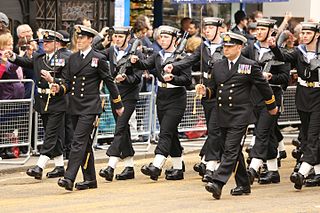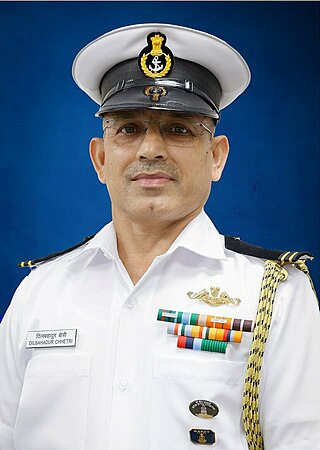History

1947-2023
Upon the establishment of establishment of India's independence in 1947, the country became a dominion within the British Commonwealth of Nations; nevertheless, the armed forces, namely, the British Indian Army (BIA), the Royal Indian Navy (RIN) and the Royal Indian Air Force (RIAF) - under the helm of King George VI as the Commander-in-Chief, retained their respective pre-independence ranks and corresponding insignia. [2]
In May 1949, Lord Mountbatten, the inaugural Governor-General of India and himself a naval officer, dispatched a note to Prime Minister Jawaharlal Nehru, titled Names and Insignia of Indian Armed Forces, containing a list of suggestions regarding the nomenclature of the armed forces that were to be enforced upon the dominion's conversion to a republic. [2] In the note, Mountbatten proposed that the future IN should retain its predecessor's nomenclature as much as possible - advocating the retention of the RIN's ranks, insignia and uniforms; the only exemption to these retentions was the force's naval ensign, which was modified to feature the Indian tricolor as a substitute for the Union Jack. [2] In September 1949, Nehru forwarded the proposals to the country's minister of defence, Baldev Singh, recommending Mountbatten's suggestions, which were consequently enforced upon India's emergence as a republic on 26 January 1950. [2]
2023 modifications
In December 2022, Admiral R. Hari Kumar, the IN's Chief of the Naval Staff (CNS), proposed several alterations to the force's rank structure, namely, a proposal to drop the rank of Petty Officer and to integrate IN ranks with that of the IA and the IAF, reasoning the present rank nomenclature reflected of what was termed by several as a colonial mindset. [3]
Following a review of the IN rank structure in October 2023, the IN announced that the rank nomenclature of the Personnel Below Officer Rank (PBOR) cadre would be revised to reflect a gender-neutral perspective. [4] Multiple sources indicated that the seven ranks of the PBOR cadre, namely, Master Chief Petty Officer Ist Class, Master Chief Petty Officer IInd Class, Chief Petty Officer, Petty Officer, Leading Seaman, Seaman Ist Class and Seaman IInd Class, would be allotted Indian-origin names. [5]
Consequently, the revision plan was publicized during the IN's 2023 Navy Day celebrations, when prime minister Narendra Modi announced that the rank structure's designations would be retitled with domestic names to reflect Indian-origin traditions, while the shoulder board epaulettes worn by flag officers would be altered to bear the octagonal-shaped naval crest, which had been adopted by the IN the previous year. [5] Accordingly, the alterations to the flag officer insignia were revealed later that month; notably, other observable emendations in the new insignia included the introduction of an Indian sword-cum-telescope design in lieu of the older sword-cum-baton design and a gold button embossed with a clear anchor in lieu of a fouled anchor. [6]
Structure
Presently, the IN's rank hierarchy is divided into three broad categories:
- Commissioned Officers (CO)
- Junior Commissioned Officers (JCO)
- Non-Commissioned Officers (NCO)

































